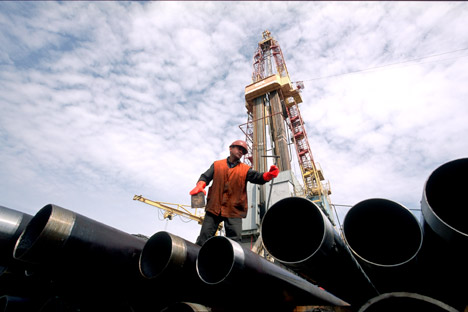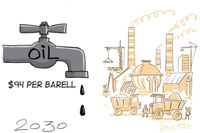ESPO to be new Russian oil benchmark for Asia

ESPO to be new Russian oil benchmark for Asia. Source: ITAR-TASS
The project to extend the Eastern Siberia–Pacific Ocean (ESPO) oil pipeline to the Far Eastern port of Kozmino will enable Russia to double its ESPO crude deliveries to the world market. This will suffice for the ESPO blend to become the marker crude in the Pacific region and become one of the major benchmarks in the world, alongside Brent and WTI, and outsell Urals, another Russian oil blend.
Supertankers exceeding 100,000 deadweight tonnes berth at the loading terminal of Specialised Oil Port Kozmino (the official name) every two days. Some 1.5 million tonnes of light and sweet crude from Eastern Siberian fields are loaded every month. In 2012, Russian ESPO blend supplies to the world market will amount to around 15 million tonnes. The same amount will be sent to China by pipeline, under a long-term contract (the buyer is CNPC). ESPO sales will thus total 30 million tonnes.
Yet, six years ago, there were no oil flows whatsoever. The reason was that the other Russian oil pipelines go from the fields in Western Siberia (at least 3,000 kilometres to the West from Eastern Siberia) to the West, so there was no sense in making crude oil in a new location before the ESPO pipe was built. Things are different now. Oil production in Eastern Siberia is growing at an astonishing pace. In 2012, oil output in the region will reach 30 million tonnes (223 million barrels). The second stage of the ESPO pipe will connect Eastern Siberia with Russia’s Far East coast (up until now, crude has been delivered to Kozmino by rail from Skovorodino station of, near Baikal). The new pipe will enable exports of up to 50 million tonnes (372 million barrels) of oil annually, exclusive of deliveries to China.
In 2013, export supplies via Kozmino are expected to reach 22 million tonnes (164 million barrels).
So far, there has been no crude benchmark in the Pacific region. The Dubai blend traded in Singapore is currently the local marker crude, meaning that it serves as a reference point for determining the cost of many other grades, although Espo has better characteristics than Dubai. The Eastern Siberian crude is lighter and contains less sulphur (its API gravity is 34.8 degrees and the sulphur content is 0.62 percent, which compares to 31 degrees and 2 percent for Dubai). So the Russian blend has every chance of becoming a new benchmark, if certain conditions are met.
Another weakness of Dubai is the long haul distance. This is one of the main reasons that the Pacific region is not the main market for Dubai, which it is still an alien grade here.
All the oil importers of the Asia-Pacific Region are interested in having Espo become a benchmark crude, with prices determined as a result of trading on the exchange, rather than as a discount to some other reference crude. “The gap between the WTI and Brent price quotations (the American blend has been 20 percent less expensive than its European counterpart since the escalation of the 2008 economic setback – editor) makes it clear that consumers will find it more profitable to have a local benchmark for setting prices”, says independent analyst Alexander Kovalev.
Espo already has its own set of consumers. In 2011, the main buyers of this blend were the United States (27 percent of the total), Japan (19 percent), China (18 percent), and South Korea (13 percent), followed by the Philippines, India and Indonesia.
The main conditions that need to be met for Espo to enjoy the status of a marker oil consist in quality stabilisation and an increase in transport capacity, Platts President Larry Neal said back in the August 2010.
Espo has been exported for three years now and the blend already enjoys a high reputation. The main advantage of the Russian blend is the shorter haul distance compared to crudes delivered from the Middle East – deliveries take from three to seven days, compared to weeks. The quality of the blend was inconsistent at first but is now stable. “Some traders used to have complaints about the inconsistent quality of the Espo blend but this is no longer the case, given that Espo is coming and will keep coming mostly from three fields (Vankorskoe, Talakanskoe and Verkhnechonskoe). The first of these provides the main volume of Espo. They might have referred to excess chloride content, but that was registered in the initial stages”, says Dmitry Alexandrov, head of analysis at Univer Capital investment company.
In December, when the second stage of the ESPO pipe is projected to be launched, oil transport costs will be cut by $80 per tonne, or about 10 percent of its market value. The pipeline will have a capacity of 80 million tonnes per year once the project is complete. The share of Russian crude on the Asia-Pacific Region market will expand to 5.5 percent from the current 3.8 percent and may further increase to 8 percent, according to the plan announced by Transneft (the ESPO owner) last year.
Yet the problem of consistent supplies of Espo crude to the global market still needs to be tackled. A separate blend with its own market niche needs to sell at least 20-30 million tonnes annually but, in order to compete effectively with Dubai for the status of a reference crude, at least 50 million tonnes need to be sold. The ESPO-2 pipe, once launched, will create a sufficient potential to increase sales. In the long run, some 30 million tonnes will be delivered to China by pipe and another 50 million tonnes will be exported via Kozmino. Traders will benefit from tanker supplies, which will give Espo a boost on its way to becoming a benchmark. Launch of the second ESPO stage will increase supply reliability and speed, after which “Russian crude will become an alternative to that supplied from the Near East, making Espo a global scale project”, says Alexei Kokin, an analyst at Metropol.
It takes years, if not decades, to establish benchmarks, so Espo will require at least two or three years to become one. One reason for this is that new producers filling the ESPO pipeline with crude will only become operational in 2015.
All rights reserved by Rossiyskaya Gazeta.
Subscribe
to our newsletter!
Get the week's best stories straight to your inbox

